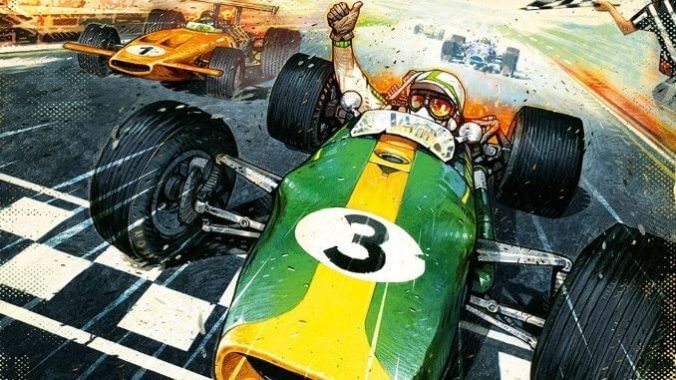Car-racing seems like an obvious theme for gaming, whether at the tabletop or at the arcade. I was an absolute sucker for Out Run as a kid, by which I mean I would always play it and never win, or even come close. (Hang on a minute—I need to buy the Out Run port for my kid’s Switch.) Downforce, previously known as Top Race, has been the king of car-racing board games for a while now, while the genre has seen more than its share of duds (anyone remember Milton Bradley’s Turbo?).
About five years ago, we got a fun bike-racing game called La Flamme Rouge that brought a little press-your-luck element to the genre while also incorporating some little tweaks to help the trailing players avoid falling too far behind. One of the designers of that game is co-designer of Heat: Pedal to the Metal, which improves on La Flamme Rouge while keeping some of its best mechanics, now with cars racing around one of four tracks as players try to manage their decks of speed cards to get ahead without overheating.
In Heat, one to six players compete to finish a set number of laps around the chosen track by playing speed cards from their hand on each turn. You can set your car anywhere from first to fourth gear, moving up one or down gear for free at the start of a turn, and then you play a number of cards that matches your current gear. You add up your speed cards’ total values and move your car that many spaces. Then you can choose to “boost” by adding a Heat card to your deck and drawing until you get another speed card of value 1 to 4, and if you’re in dead last (up to four players) or second-to-last (five to six players), you get one extra point of speed and move one more space. If you end your turn behind another car or next to one, you can “slipstream” and go around it, which was part of La Flamme Rouge’s rules as well. That’s it—that’s the whole game!

Ah, if only it were that simple. But you are at the wheel of a complicated piece of precision engineering, and it’s prone to overheating and inconsistency. You start the game with several Stress cards in your hand, which require you to draw cards from your deck until you get a regular speed card, so it’s quite possible that your car will go a lot faster than you’d intended—and sometimes that’s not such a great thing. You also have a set of Heat cards that aren’t in your deck, but that make their way into your deck as the game progresses, such as if you choose to raise or lower your gear by two rather than just one.
The main way you can get stuck with a bunch of Heat cards is by taking a turn too fast. Every board has a handful of corner spaces marked with a maximum speed. If your total speed on a turn when you cross a corner line exceeds that maximum, you must pay the difference by adding Heat cards from your board to your deck equal to that difference. If you don’t have enough Heat cards to do this, you “spin out,” adding all the Heat cards you can, dropping back to first gear, adding more Stress cards to your deck, and moving back to the first space before the corner line. Your speed includes anything extra you got by boosting, and the (optional) bonus space you get from being at the back of the pack. It’s bad, but sometimes you just get stuck, because you must play cards equal to your gear number, and sometimes that forces you to play a Stress card or two. Stress cards are forever, but you can ditch Heat cards if you’re in first or second gear, or if you’re in last place.
Play continues until you’ve completed that track’s lap requirement and everyone has finished. You can also go in tournament mode and play all four tracks in succession, adding up the points each player got from their various finishes. Heat: Pedal to the Metal also comes with an advanced mode that’s effectively a huge expansion that turns it into a much more complex game where you’re tricking out your engine with all kinds of enhancements or dealing with weather and other external events. There’s even a solo mode available, and now fans of the game have begun designing custom tracks you can print out at home.
Heat: Pedal to the Metal came out in the last part of 2022 from Days of Wonder, the publisher of Ticket to Ride, Five Tribes, and Small World, a good sign that a game will have high-quality components and excellent artwork—which it does, including art by Vincent Dutrait, whose illustrations also feature in Jaipur and Broom Service. The track boards are all distinctive and interesting, and you can also see numbers along the track in a smaller typeface showing how many spaces remain until the next corner line, a very smart and simple addition to keep the game accessible to more players. The base game alone hits that perfect combination of ease of learning and intellectual challenge, the kind of game you can play with a mixed group of gamers and non-gamers, adults and kids, and get everyone laughing and having a good time. Just make sure you carry some cool water in your trunk.
Keith Law is the author of The Inside Game and Smart Baseball and a senior baseball writer for The Athletic. You can find his personal blog the dish, covering games, literature, and more, at meadowparty.com/blog.

